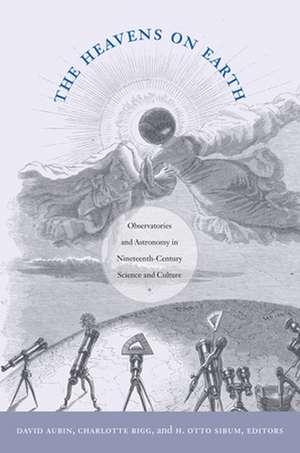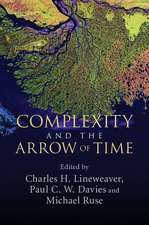The Heavens on Earth – Observatories and Astronomy in Nineteenth–Century Science and Culture: Science and Cultural Theory
Autor David Aubin, Charlotte Bigg, H. Otto Sibumen Limba Engleză Paperback – 25 ian 2010
The contributors examine "observatory techniques" developed and used not only in connection with observatories but also by instrument makers in their workshops, navy officers on ships, civil engineers in the field, and many others. These techniques included the calibration and coordination of precision instruments for making observations and taking measurements; methods of data acquisition and tabulation; and the production of maps, drawings, and photographs, as well as numerical, textual, and visual representations of the heavens and the earth. They also encompassed the social management of personnel within observatories, the coordination of international scientific collaborations, and interactions with dignitaries and the public. The state observatory occupied a particularly privileged place in the life of the city. With their imposing architecture and ancient traditions, state observatories served representative purposes for their patrons, whether as symbols of a monarch's enlightened power, a nation's industrial and scientific excellence, or republican progressive values. Focusing on observatory techniques in settings from Berlin, London, Paris, and Rome to Australia, Russia, Thailand, and the United States, "The Heavens on Earth" is a major contribution to the history of science. "Contributors" David Aubin, Charlotte Bigg, Guy Boistel, Theresa Levitt, Massimo Mazzotti, Ole Molvig, Simon Schaffer, Martina Schiavon, H. Otto Sibum, Richard Staley, John Tresch, Simon Werrett, Sven Widmalm
Preț: 308.90 lei
Nou
Puncte Express: 463
Preț estimativ în valută:
59.11€ • 61.88$ • 48.91£
59.11€ • 61.88$ • 48.91£
Carte tipărită la comandă
Livrare economică 07-21 aprilie
Preluare comenzi: 021 569.72.76
Specificații
ISBN-13: 9780822346401
ISBN-10: 0822346400
Pagini: 400
Ilustrații: 62 illustrations
Dimensiuni: 163 x 233 x 30 mm
Greutate: 0.68 kg
Editura: MD – Duke University Press
Seria Science and Cultural Theory
ISBN-10: 0822346400
Pagini: 400
Ilustrații: 62 illustrations
Dimensiuni: 163 x 233 x 30 mm
Greutate: 0.68 kg
Editura: MD – Duke University Press
Seria Science and Cultural Theory
Cuprins
Contributors: David Aubin, Charlotte Bigg, Guy Boistel, Theresa Levitt, Massimo Mazzotti, Ole Molvig, Simon Schaffer, H. Otto Sibum, Richard Staley, John Tresch, Simon Werrett, Sven Widmalm
Recenzii
This impressive volume is the first to offer a panoramic view of the observatory as site of science, empire, and modernization during its golden age. At the forefront of precision measurement, standardization, number-crunching, and worldwide networking, the nineteenth-century observatory made globalization a reality.Lorraine Daston, Max Planck Institute for the History of Science, Berlin
The Heavens on Earth raises the bar for the historiography of astronomy and observatory techniques. The collection stands out from the existing literature in its attention to the broad cultural context of observatory work and techniques; continental Europe in addition to Great Britain and the United States; the connections between the observatory and popular astronomy; and the links between astronomy and concerns such as geodesy, the rating of chronometers, and military science. It is a major contribution to the history of not only astronomy but also nineteenth-century science and its culture.Robert W. Smith, University of Alberta
"This impressive volume is the first to offer a panoramic view of the observatory as site of science, empire, and modernization during its golden age. At the forefront of precision measurement, standardization, number-crunching, and worldwide networking, the nineteenth-century observatory made globalization a reality."--Lorraine Daston, Max Planck Institute for the History of Science, Berlin "The Heavens on Earth raises the bar for the historiography of astronomy and observatory techniques. The collection stands out from the existing literature in its attention to the broad cultural context of observatory work and techniques; continental Europe in addition to Great Britain and the United States; the connections between the observatory and 'popular' astronomy; and the links between astronomy and concerns such as geodesy, the rating of chronometers, and military science. It is a major contribution to the history of not only astronomy but also nineteenth-century science and its culture."--Robert W. Smith, University of Alberta
The Heavens on Earth raises the bar for the historiography of astronomy and observatory techniques. The collection stands out from the existing literature in its attention to the broad cultural context of observatory work and techniques; continental Europe in addition to Great Britain and the United States; the connections between the observatory and popular astronomy; and the links between astronomy and concerns such as geodesy, the rating of chronometers, and military science. It is a major contribution to the history of not only astronomy but also nineteenth-century science and its culture.Robert W. Smith, University of Alberta
"This impressive volume is the first to offer a panoramic view of the observatory as site of science, empire, and modernization during its golden age. At the forefront of precision measurement, standardization, number-crunching, and worldwide networking, the nineteenth-century observatory made globalization a reality."--Lorraine Daston, Max Planck Institute for the History of Science, Berlin "The Heavens on Earth raises the bar for the historiography of astronomy and observatory techniques. The collection stands out from the existing literature in its attention to the broad cultural context of observatory work and techniques; continental Europe in addition to Great Britain and the United States; the connections between the observatory and 'popular' astronomy; and the links between astronomy and concerns such as geodesy, the rating of chronometers, and military science. It is a major contribution to the history of not only astronomy but also nineteenth-century science and its culture."--Robert W. Smith, University of Alberta
Textul de pe ultima copertă
""The Heavens on Earth" raises the bar for the historiography of astronomy and observatory techniques. The collection stands out from the existing literature in its attention to the broad cultural context of observatory work and techniques; continental Europe in addition to Great Britain and the United States; the connections between the observatory and 'popular' astronomy; and the links between astronomy and concerns such as geodesy, the rating of chronometers, and military science. It is a major contribution to the history of not only astronomy but also nineteenth-century science and its culture."--Robert W. Smith, University of Alberta, co-author of "Hubble: Imaging Space and Time"
Notă biografică
Descriere
A cultural history of astronomy in the 19th century that focusses on the issues and perspectives on the role of the observatory in science, society, and culture.





























